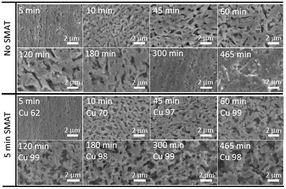Bulk monolithic electrodes enabled by surface mechanical attrition treatment-facilitated dealloying†
Abstract
A convenient method is developed for mass producing porous bulk metallic nanostructures with high purity, fine nanostructures of high specific surface areas, and improved mechanical performance, at low cost and high production rates. Alloys are first mechanically pretreated and grain-refined using the convenient surface mechanical attrition treatment (SMAT) and then dealloyed in an etchant solution. The reactive metal component can be effectively removed at an accelerated rate, while the more inert metal component forms a porous structure with finer porous features (e.g., ligament size) and largely suppressed “self-coarsening” effects (the undesired structural rearrangement upon long-time soaking in the etchant that results in larger structural features reducing the material overall surface area), leading to a bulk metallic framework of a well-defined nanoporous morphology and a remarkable thickness of the mm order. Monolithic supercapacitor electrodes of superior performance are enabled by coating NiIIIOOH onto the bulk porous Cu frameworks fabricated using this novel method.


 Please wait while we load your content...
Please wait while we load your content...